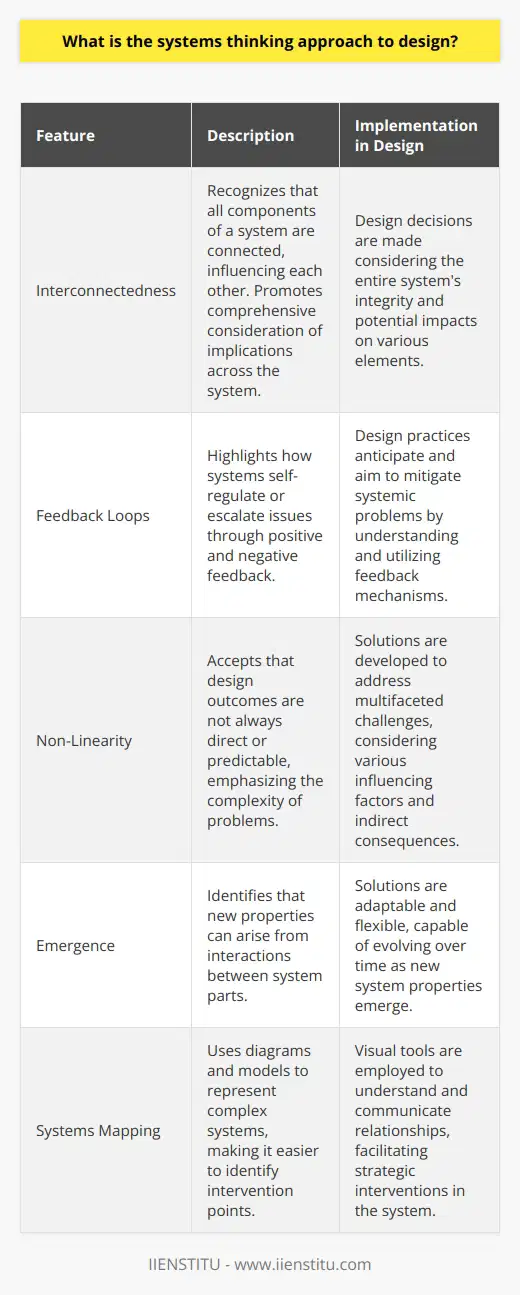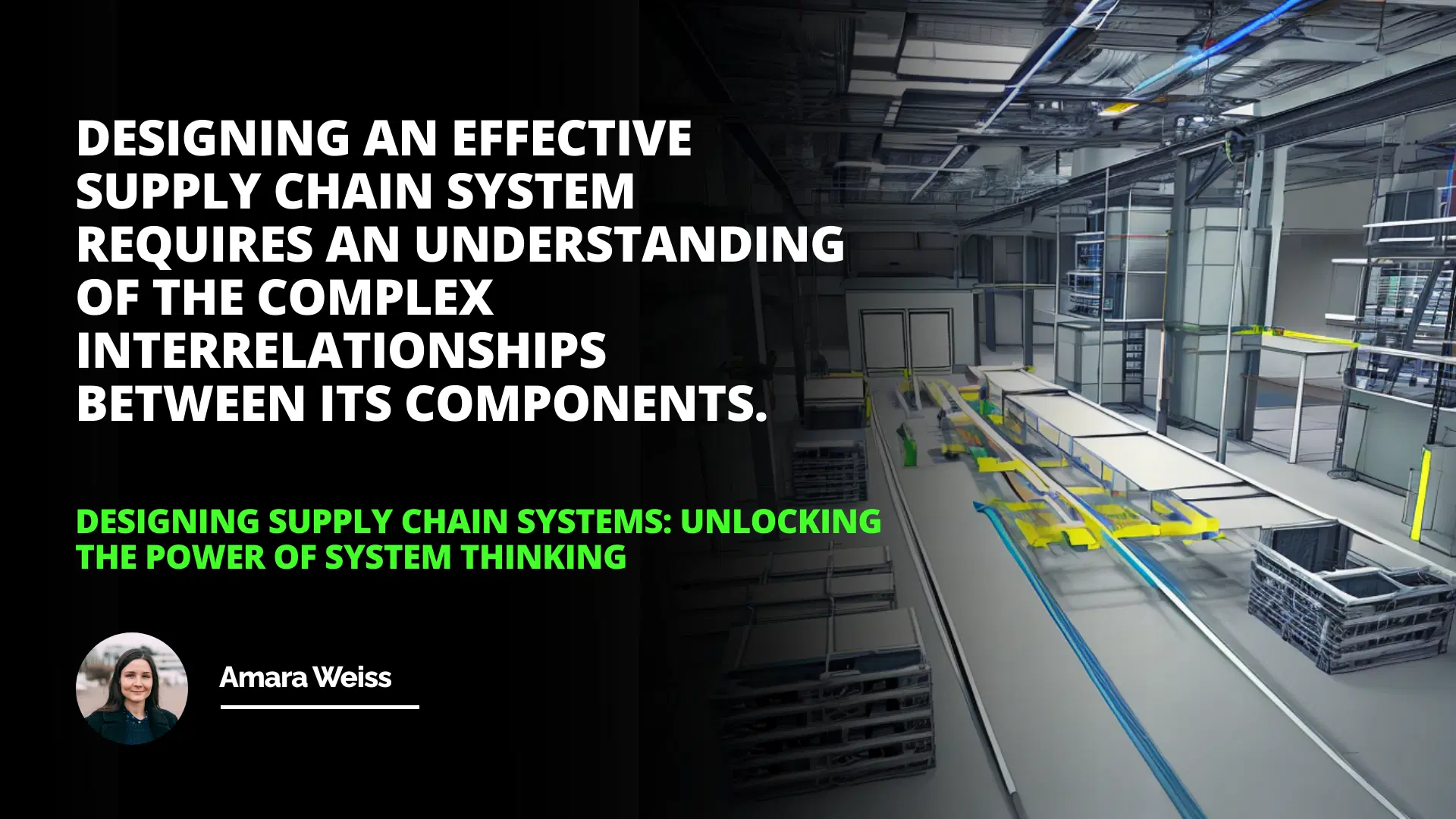
This article discussed supply chain systems and their components. It discussed how supply chains have become more complex and important as businesses become increasingly globalized. It also discussed the components of a supply chain system, including people, processes, and technologies, and how recognizing the rules and patterns of supply chain systems is essential for businesses to remain competitive.
Introduction
What is a Supply Chain System?
Components of a Supply Chain System
Recognizing the Rules and Patterns of Supply Chain Systems
Conclusion
Introduction: A supply chain is a system of interconnected components that move goods from the supplier to the customer. It is a complex system that requires careful planning and management to ensure that all components work properly and efficiently. As businesses become increasingly globalized, supply chains have become more complex and important. Understanding the components of a supply chain system and recognizing the rules and patterns of supply chain systems is essential for businesses to remain competitive.
What is a Supply Chain System?
A supply chain system is a network of interconnected components that work together to move goods from the supplier to the customer, including people, processes, and technologies. It is a complex system that requires careful planning and management to ensure that all components work correctly and efficiently. The supply chain system is divided into three main parts: the upstream (supply) side, the midstream (production) side, and the downstream (distribution) side. The upstream side includes the suppliers and the materials they provide, the midstream includes the production processes and the downstream includes the distribution channels and the customers.
Components of a Supply Chain System
The components of a supply chain system include people, processes, and technologies. People include suppliers, manufacturers, distributors, retailers, and customers. Processes include procurement, production, distribution, and customer service. Technologies include software, hardware, and networks.
Recognizing the Rules and Patterns of Supply Chain Systems
When looking at a supply chain system as a system, it is important to recognize the rules and patterns that govern the system. These rules and patterns are determined by the system's components and interactions. For example, a supplier may have a particular set of rules and processes for their procurement process, while a manufacturer may have a different set of rules and processes for their production process. Similarly, a distributor may have different rules and processes for their distribution process. Understanding these rules and patterns is essential for businesses to remain competitive.
Conclusion: A supply chain system is a complex system of interconnected components, including people, processes, and technologies, that work together to move goods from the supplier to the customer. Understanding the components of a supply chain system and recognizing the rules and patterns of supply chain systems is essential for businesses to remain competitive. With careful planning and management, businesses can ensure that their supply chain system is working properly and efficiently and can remain competitive in today’s globalized world.
Designing an effective supply chain system requires understanding the complex interrelationships between its components.
The article covered the importance and complexity of supply chain systems, highlighting the vital role it plays in the globalized business landscape. It mentioned the core components of the supply chain: people, processes, and technologies, which are interconnected to facilitate the movement of goods from a supplier to a customer. The significance of recognizing rules and patterns within supply chain systems was underscored as key to maintaining business competitiveness. Refining one's understanding of these systems might necessitate undertaking a supply chain management online course, which could potentially aid in understanding the interrelationships between the components of the supply chain system, allowing for better planning and management.
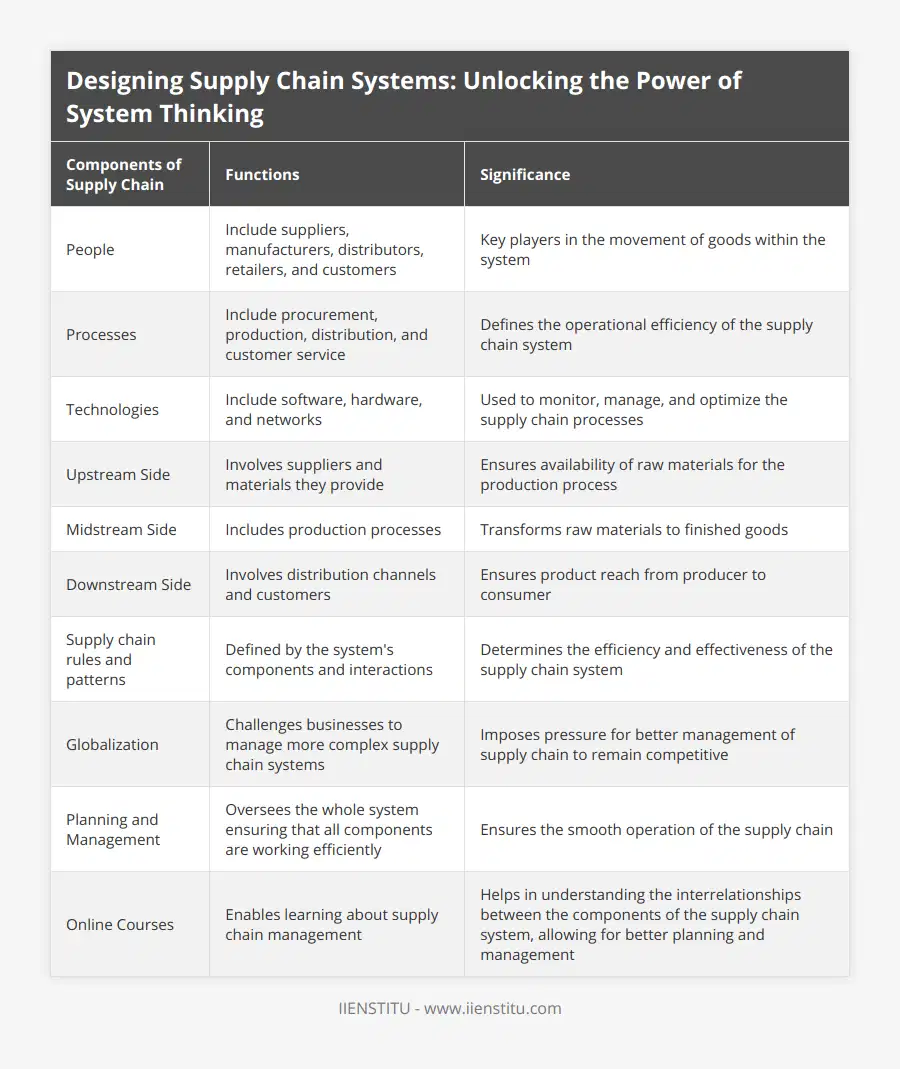
Frequently Asked Questions
What are the components of a supply chain system?
The components of a supply chain system include people, processes, and technologies. People in a supply chain system are responsible for managing resources and coordinating activities. Processes are the steps and tasks that occur throughout the supply chain. Lastly, technologies are the digital tools used to manage, monitor, and analyze the flow of materials, information, and money. Recognizing the rules and patterns of supply chain systems is essential for businesses to remain competitive in today's globalized world.
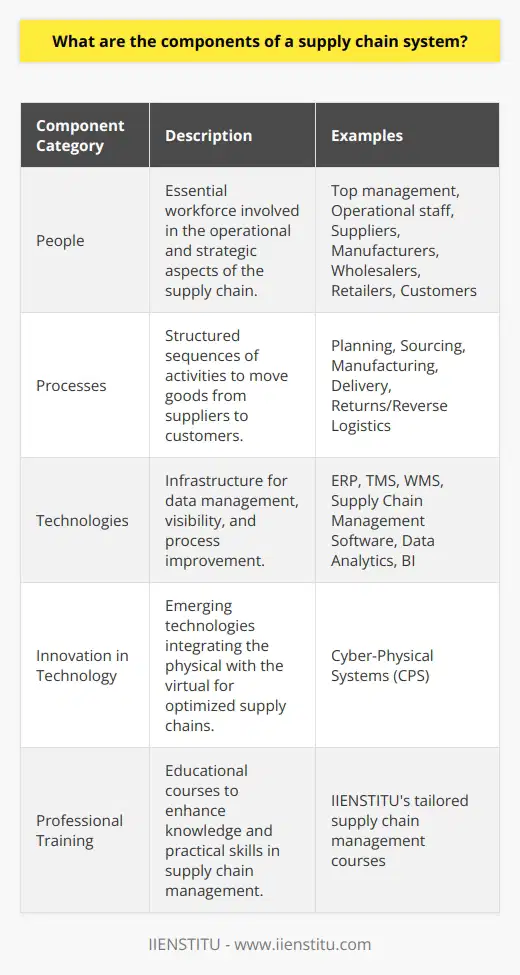
How can recognizing the rules and patterns of supply chain systems help to unlock the power of system thinking?
Recognizing the rules and patterns of supply chain systems can help businesses unlock the power of system thinking by allowing them to better anticipate and respond to changes in the market. It can also help them identify opportunities for improvement and innovation in their supply chain, as well as identify risks and potential problems. System thinking can help businesses optimize their supply chain operations and ensure they remain competitive in an ever-changing landscape.

What are the benefits of designing a supply chain system?
The benefits of designing a supply chain system include improved efficiency and cost savings, increased visibility and control, better customer service and satisfaction, and improved supply chain performance. Designing a supply chain system can also help businesses to reduce risk, increase productivity and responsiveness, and achieve sustainable growth. By understanding the rules and patterns of supply chain systems, businesses can gain a competitive advantage and be better positioned to capitalize on new opportunities.
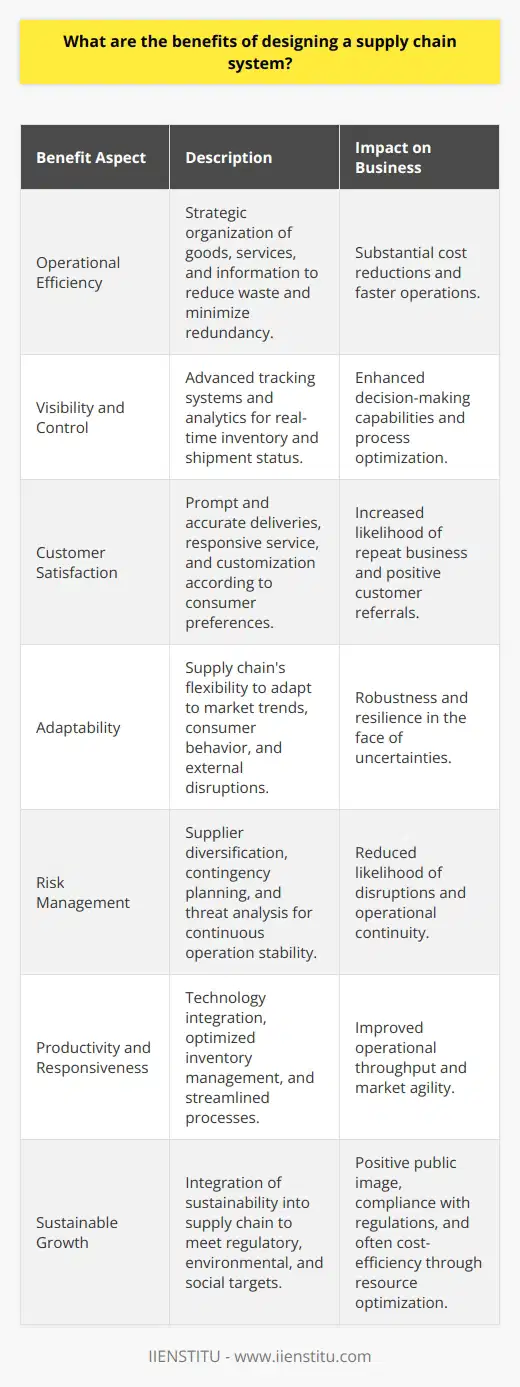
What is the role of systems thinking in optimizing supply chain management?
Role of Systems Thinking in Supply Chain Management
Understanding Interconnectedness
The role of systems thinking in optimizing supply chain management (SCM) primarily involves deepening our understanding of the interconnectedness of elements within SCM processes. Systems thinking advocates for the investigation of complex relationships between components, rather than analyzing them in isolation, enabling decision-makers to identify points of leverage and areas for improvement.
Adopting a Holistic Approach
By taking a holistic approach to address the multifaceted nature of SCM, businesses can gain a comprehensive perspective on their entire supply chain network. This includes acknowledging the influence of various external factors, such as geopolitical, environmental, and technological changes, in addition to internal organizational factors like procurement, production, inventory, and transportation management.
Improving Operational Efficiency
As a result of adopting systems thinking in SCM, organizations can improve operational efficiency by addressing bottlenecks, reducing lead times, and ensuring responsiveness to changing customer demands. This involves evaluating the performance of supplier networks, manufacturing capabilities, and distribution networks to identify areas of improvement and attain a competitive edge in the market.
Enhancing Collaboration and Communication
Systems thinking fosters enhanced collaboration and communication among all stakeholders within the supply chain, including suppliers, manufacturers, distributors, and customers. By recognizing the interdependence of these stakeholders, organizations can develop effective strategies to coordinate and integrate their activities, leading to the successful execution of supply chain processes.
Encouraging Sustainability and Risk Management
Lastly, systems thinking in SCM allows organizations to prioritize sustainability and risk management by considering the long-term implications of their decisions on the environment, society, and economy. This involves implementing strategies such as waste reduction, energy efficiency, and ethical sourcing to minimize negative impacts, while also addressing potential risks and disruptions to the supply chain.
In conclusion, adopting systems thinking in SCM enables organizations to optimize their supply chain processes through comprehensive analysis, improving efficiency, promoting collaboration, and prioritizing sustainability and risk management. By recognizing and addressing the interconnected nature of supply chain elements, businesses can successfully navigate and adapt to rapid market changes and achieve long-term success.
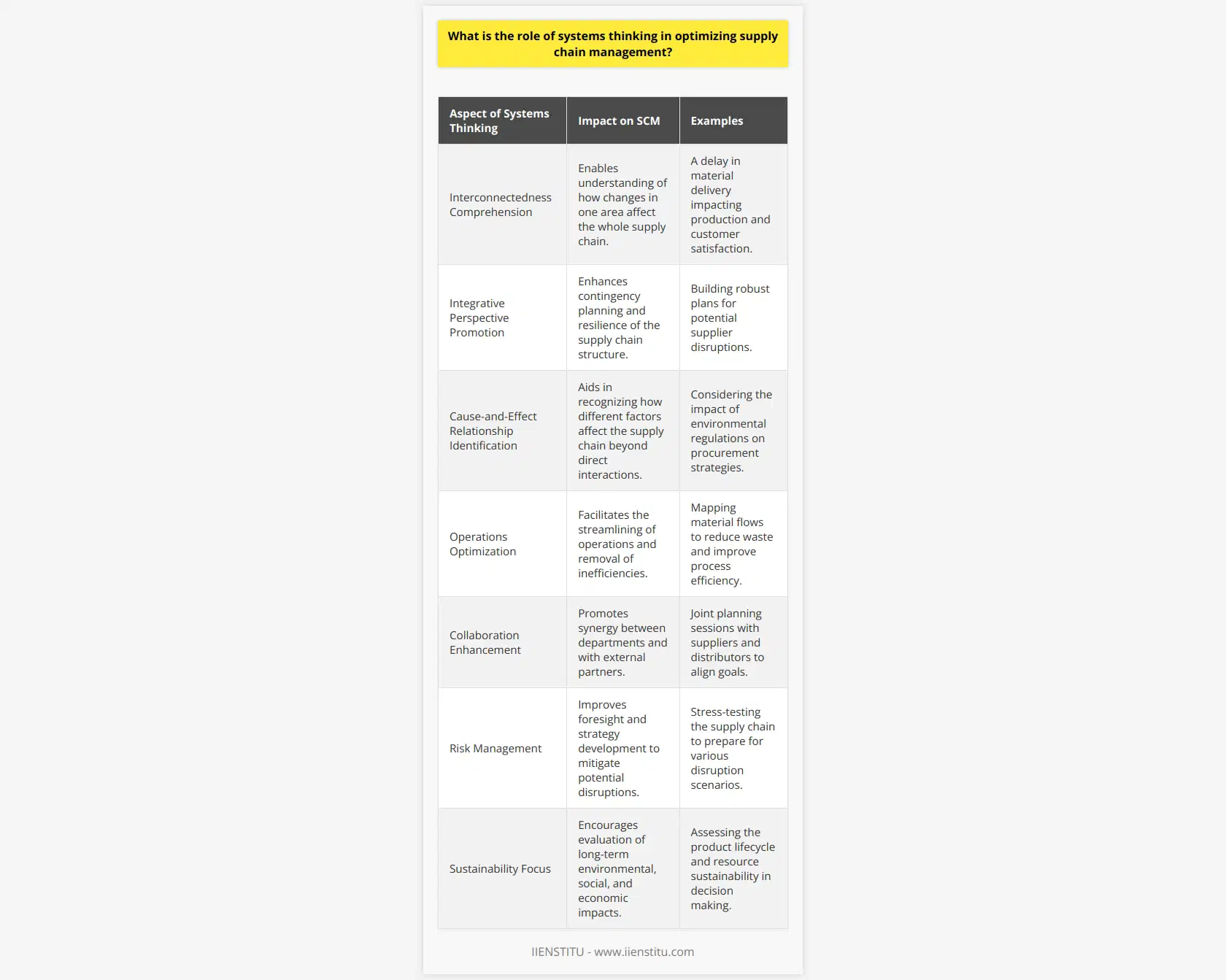
Which key processes must be considered when designing an effective supply chain strategy?
Key Components of Supply Chain Strategy
Defining Goals and Objectives
When designing an effective supply chain strategy, the first step is to establish clear goals and objectives. These should align with the organization's overall business objectives and provide a roadmap for decision-making throughout the various stages of the supply chain.
Evaluating Current Performance
Next, it is crucial to analyze the current performance of the supply chain, identifying key strengths and weaknesses. This evaluation should include a thorough review of current processes, technology, and systems, as well as external factors influencing the supply chain, such as economic conditions and environmental factors.
Market and Customer Analysis
Understanding a company's target market and customers is essential for developing an optimal supply chain strategy. This includes conducting market research, collecting customer feedback, and analyzing industry trends to create a demand-driven, customer-centric supply chain.
Developing Partnerships and Relationships
An effective supply chain strategy emphasizes strong relationships with suppliers, logistics providers, and other key players within the industry. These partnerships should be built on trust, collaboration, and shared objectives to create mutually beneficial outcomes and ensure seamless processes throughout the supply chain.
Process Integration and Optimization
Integrating and optimizing processes is a core element of an effective supply chain strategy. This may involve implementing lean manufacturing principles, increasing automation or digitization, and instilling continuous improvement practices to enhance efficiency and reduce waste.
Risk Management and Contingency Planning
Recognizing potential risks and crafting contingency plans for handling disruptions is a crucial aspect of supply chain strategy. This involves analyzing factors such as potential supply shortages, transportation delays, and currency fluctuations, as well as developing alternative plans to mitigate the impact of unforeseen issues on the supply chain.
Performance Measurement and Monitoring
Lastly, a strong supply chain strategy requires ongoing performance measurement and monitoring. This includes tracking key performance indicators (KPIs), setting benchmarks for improvement, and implementing regular audits to maintain the effectiveness of the supply chain strategy and ensure alignment with business objectives.
In conclusion, when designing an effective supply chain strategy, organizations must consider multiple key processes, including defining clear goals and objectives, evaluating current performance, understanding market and customer needs, developing strong partnerships, optimizing processes, managing risks, and tracking performance. By considering these factors, companies can create a robust and adaptable supply chain strategy that drives both short-term and long-term success.

How can the critical step of supply chain system design be accurately defined in order to ensure successful implementation?
Defining the Critical Step in Supply Chain System Design
To accurately define the critical step of supply chain system design and ensure successful implementation, it is essential to first establish its primary objectives. These objectives should address specific business needs, such as reducing costs, improving efficiency, streamlining processes, and enhancing customer satisfaction. By clearly identifying the goals of the system design, subsequent steps can be tailored to achieve these objectives and facilitate successful implementation.
Mapping Out the Supply Chain
Defining the critical step also requires a comprehensive understanding of the existing supply chain process. This includes mapping out the current process, identifying inefficiencies or weaknesses, and highlighting opportunities for enhancement. Each subprocess should be scrutinized in detail to ensure that the designed system fully meets the requirements of every aspect of the supply chain.
Stakeholder Collaboration
Collaboration with stakeholders is an essential aspect when determining the critical step. This involves engaging with both internal and external stakeholders, such as suppliers, customers, and partners, to gather their input and ensure that the system meets their needs. This collaborative approach can help identify potential issues, preemptively mitigate risks, and align expectations for the system design's goals.
Developing Performance Metrics
Establishing robust performance metrics is critical to accurately defining the supply chain system's critical step. Such metrics should align with the design's objectives and measure the success or failure of the implemented system. The key performance indicators (KPIs) should be quantifiable and relevant to the business's unique needs, enabling continuous improvement and adaptability based on the data gathered.
Risk Assessment and Mitigation
A crucial element in defining the critical step of supply chain system design is assessing potential risks and developing strategies to mitigate them. Risks may range from technical challenges to market fluctuations and supplier disruptions, among others. A proactive approach in assessing these risks can provide insights into optimizing system design and ensuring that the implementation process is smooth and successful.
Continuous Evaluation and Adaptation
Lastly, a constant effort must be made to evaluate and adapt the system design even after its implementation. Changes in business requirements, market demands, or customer expectations can impact the supply chain's objectives. By continuously assessing the system's success and making necessary adjustments, businesses can ensure that their supply chain design remains accurate and effective in driving success.
In conclusion, accurately defining the critical step of supply chain system design requires a multifaceted approach that encompasses mapping processes, collaboration with stakeholders, development of performance metrics, risk assessment, and continuous adaptation. By following these steps, businesses can create a resilient and responsive supply chain system that achieves their core objectives and promotes organizational success.
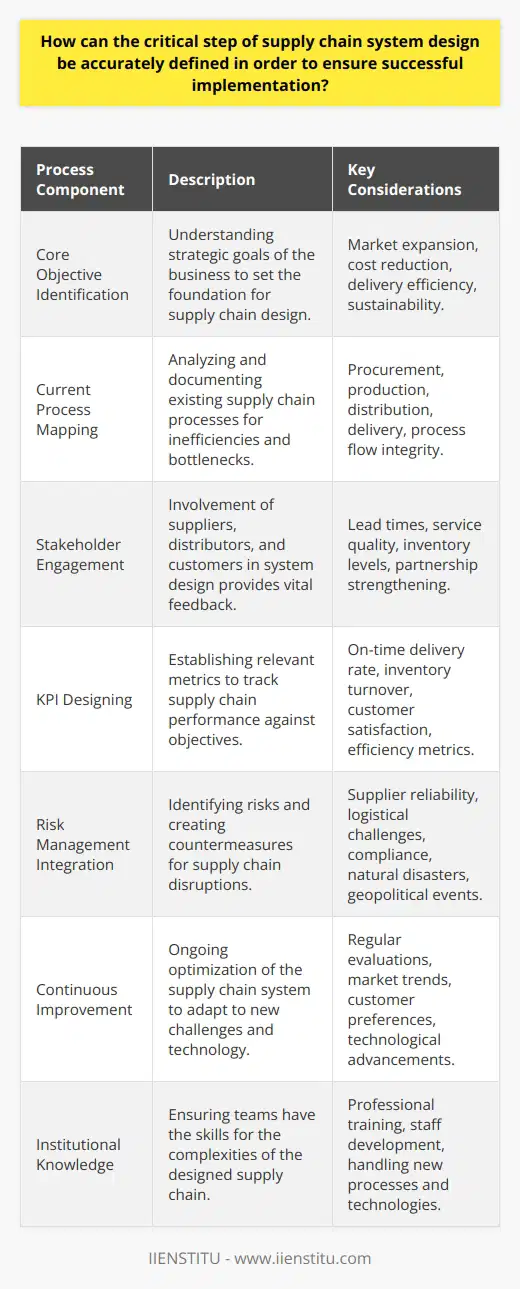
What is the definition of the most critical step of designing supply chain system?
Defining the Critical Step in Supply Chain Design
Supply chain design is a complex process that involves multiple steps to ensure the efficient and effective movement of goods and services from suppliers to customers. However, the most critical step in designing a supply chain system is arguably the initial stage of strategic planning and analysis. This encompasses identifying the company's objectives, aligning the supply chain with those objectives, and determining the best methods to achieve them.
Strategic Planning and Objective Setting
The success of a supply chain depends on its ability to meet the demands and requirements of both the company and its customers. The strategic planning process begins with setting clear objectives for the supply chain. These objectives may include minimizing costs, maximizing revenue, ensuring on-time delivery, or improving the overall flexibility and responsiveness of the system. Moreover, having a clear understanding of the company's goals is crucial in making informed decisions about various aspects such as inventory management, transportation, and sourcing strategies.
Alignment with Company Goals
Once the objectives are defined, it's essential to align the entire supply chain with the company's goals. This involves ensuring that all stakeholders, both internal and external, have a clear understanding of these objectives and are committed to achieving them. By aligning the supply chain with the company's goals, managers can better prioritize resources and focus on the most critical aspects of the system that will have the most significant impact on achieving success.
Selection of Strategies and Methods
Choosing the best strategies to meet the objectives is a critical part of the supply chain design process. For example, a company that aims to minimize costs may choose to source materials from lower-cost suppliers or implement a lean inventory management system. Alternatively, a company focused on maximizing revenue may opt to implement a demand-driven planning model, drive customization, or prioritize premium segments of the market. The chosen strategies will guide the subsequent steps in designing the supply chain system, including choosing partners, technologies, and logistics infrastructure.
In conclusion, the most critical step in designing a supply chain system is the initial stage of strategic planning and analysis, which involves setting clear objectives, aligning the supply chain with the company's goals, and selecting the most appropriate strategies and methods to achieve those goals. By laying a strong foundation through strategic planning, companies can optimize their supply chain systems and improve their overall competitiveness and operational efficiency.

How does systems thinking contribute to effective supply chain management?
Systems Thinking in Supply Chain Management
Understanding Complex Frameworks
Systems thinking contributes to effective supply chain management by fostering a holistic perspective of the interconnected components within a supply chain network. This approach allows managers to comprehend the complex framework of their supply chains, addressing various organizational units and interrelated functions that contribute to overall performance. Thus, it enables decision-makers to acknowledge and analyze the implications of their actions on the entire supply chain system.
Enhancing Adaptability and Responsiveness
Moreover, systems thinking promotes adaptability and responsiveness to changes in the business environment. By considering the supply chain as a dynamic system, managers can constantly monitor, evaluate and recalibrate operational processes, ensuring optimal efficiency and effectiveness in the face of fluctuating market demands and unforeseen disruptions. Consequently, this mindset helps organizations to become resilient and agile, maintaining a competitive advantage in the ever-evolving global supply chain landscape.
Optimizing Resource Utilization
The systems thinking approach also contributes to the optimal utilization of resources within the supply chain management. By encompassing a broad range of factors, such as materials sourcing, transportation, inventory management, and quality control, this method enables organizations to streamline their operations, reduce waste and redundancies, and maximize value creation for customers. As a result, businesses can enhance cost-efficiency, sustainability, and profitability through the adoption of systems thinking in the management of their supply chains.
Supporting Collaborative Decision-Making
Additionally, systems thinking fosters collaborative decision-making within the supply chain management. Through sharing and integrating data, insights, and forecasts from multiple sources, companies can make informed decisions based on comprehensive analysis and understanding of their supply chain's overall performance. This collaborative approach not only improves strategic planning and risk management, but it also encourages strong working relationships among the various stakeholders, ultimately leading to more effective supply chain operations.
In conclusion, systems thinking significantly contributes to effective supply chain management by enhancing the understanding of complex networks, promoting adaptability and responsiveness, optimizing resource utilization, and supporting collaborative decision-making. By incorporating systems thinking into their operations, organizations can achieve greater efficiency, agility, and sustainability in their supply chain management, ultimately driving success in the increasingly competitive global market.
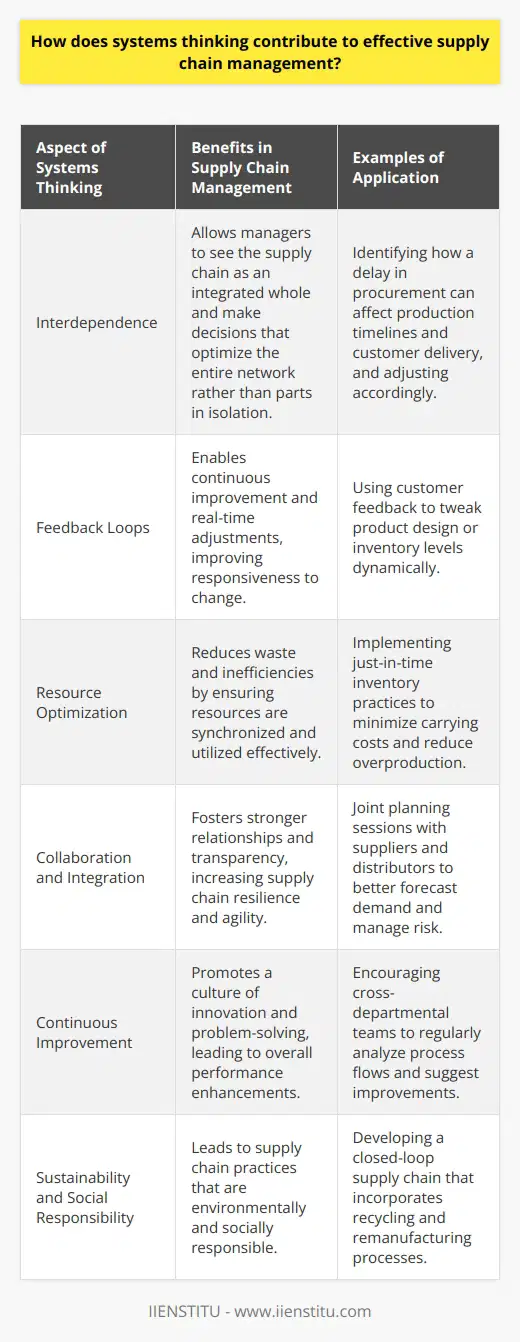
What are the benefits of supply chain network design?
Enhanced Efficiency
The primary benefit of supply chain network design is the enhancement of efficiency. By optimizing the allocation and flow of resources, businesses can reduce production and transportation costs, leading to improved profitability. Supply chain network design allows companies to balance various factors such as demand patterns, inventory levels, and fulfillment options, resulting in a streamlined system that minimizes waste and enhances customer satisfaction.
Risk Mitigation
Another advantage of supply chain network design lies in its ability to mitigate risk. In a global business environment characterized by unpredictability and uncertainty, the optimization of supply chain networks can reduce the impact of disruptions and other adverse events. By analyzing different scenarios, such as potential suppliers or transportation routes, businesses can develop contingency plans and thus increase their resilience to unexpected occurrences. As a result, supply chain network design contributes to overall risk management and aids in maintaining business continuity.
Increased Agility
In addition to enhancing efficiency and mitigating risk, supply chain network design also increases agility. This entails the ability to rapidly adapt to changes in the market, such as evolving customer demands or new regulations. By continuously analyzing the supply chain network and identifying areas for improvement, businesses can implement changes and quickly respond to market dynamics. Consequently, increased agility facilitates more rapid and informed decision-making, contributing to a competitive edge in the marketplace.
Improved Sustainability
Lastly, supply chain network design also promotes sustainability. Through optimizing resource allocation and transportation methods, businesses can significantly reduce their environmental impact by minimizing emissions and waste. Moreover, a well-designed supply chain network can support ethical and socially responsible sourcing practices, ensuring that materials and labor are obtained from sources that adhere to high standards of human rights and environmental protection. Consequently, supply chain network design contributes to the triple bottom line, delivering benefits for the environment, society, and business performance.
In conclusion, the benefits of supply chain network design are manifold, encompassing enhanced efficiency, risk mitigation, increased agility, and improved sustainability. By optimizing resources and transportation methods, businesses can achieve greater profitability while simultaneously minimizing their impact on the environment and society. As such, supply chain network design represents a critical element of modern business strategy, enabling organizations to navigate the complexities of an increasingly interconnected world while achieving their goals responsibly and sustainably.

Which are the main processes to be defined when designing the supply chain?
Key Supply Chain Processes
The main processes to be defined when designing the supply chain are as follows:
Demand and Supply Planning
It involves forecasting and evaluating the demand for products or services in the market, while ensuring the availability of necessary resources to meet that demand. Decision-makers must align current stock levels and production capacity with anticipated customer needs, accommodating any fluctuations or trends.
Sourcing and Procurement
This process involves selecting and managing suppliers to acquire the goods and services necessary to run a business. Organizations must consider factors such as cost, quality, reliability, and sustainability while developing and maintaining relationships with suppliers to ensure consistent procurement and timely delivery of materials.
Production and Manufacturing
This stage refers to the transformation of raw materials, components, or services into finished goods. Companies must establish effective production systems that ensure high-quality, efficient, and cost-effective manufacturing processes, incorporating innovative technologies and lean management techniques where appropriate.
Warehousing and Inventory Management
Proper management of storage facilities and inventory levels is essential for preventing overstocking or stockouts that may disrupt the supply chain. Companies must implement systems for tracking and managing their inventory levels, as well as maintaining efficient warehouse layouts and organization.
Transportation and Distribution
Efficient transportation and distribution networks are necessary for moving products from manufacturing facilities to warehouses, and from warehouses to customers. Organizations must determine the most effective transportation modes, routes, and delivery schedules to minimize costs and ensure timely delivery of products.
Order Fulfillment and Customer Service
Order fulfillment involves processing and managing customer orders, ensuring they are accurately filled, and delivered on time. It is crucial to develop a system for addressing any order issues, returns, or complaints to maintain customer satisfaction and foster loyalty.
Reverse Logistics
The process of managing the return and disposal of products, mainly due to returns, recalls, or end-of-life products, is known as reverse logistics. Companies must establish efficient systems for handling these items, determining the optimal methods for refurbishing, recycling, or disposing of them.
By correctly defining and implementing these primary supply chain processes, organizations can fulfill customer demands efficiently and cost-effectively, ensuring a competitive advantage in the market.

How do you create an effective supply chain system?
Creating an Effective Supply Chain System
Strategic Planning and Collaboration
To create an effective supply chain system, businesses must first engage in strategic planning and collaboration with their partners. This involves determining the overarching goals and objectives of the supply chain and establishing communication channels to foster cooperation between suppliers, manufacturers, and retailers.
Inventory Management
Inventory management is a key component of an effective supply chain system. This entails monitoring stock levels, maintaining accurate records, and utilizing demand forecasting techniques to minimize stockouts and overstock. By implementing a robust inventory management system, businesses can ensure that their supply chain remains efficient and cost-effective.
Demand Forecasting and Planning
In order to maintain a successful supply chain, organizations must accurately predict and plan for demand fluctuations. Utilizing data-driven prediction models and customer insights, businesses can make informed decisions about production levels and inventory management, allowing for greater efficiency and reduced waste.
Supplier Relationship Management
Maintaining strong relationships with suppliers is essential for creating an efficient supply chain system. By fostering collaborative partnerships and open communication, businesses can ensure a reliable and consistent source of materials, thereby reducing the risk of bottlenecks and potential delays.
Logistics and Distribution
An effective supply chain system also requires efficient and streamlined logistics and distribution processes. Businesses should invest in transportation management software and warehouse management systems to optimize the movement of goods through the supply chain. Additionally, implementing strategies such as cross-docking and just-in-time delivery can reduce warehouse costs and improve overall efficiency.
Continuous Improvement and Metrics
Finally, to create a successful supply chain system, organizations must continually measure and analyze the performance of their processes in order to identify areas for improvement. By monitoring key performance indicators (KPIs) such as order-fulfillment rates, lead times, and inventory turnover, businesses can make data-driven decisions aimed at enhancing their supply chain operations.
In conclusion, establishing an effective supply chain system involves strategic planning and collaboration between stakeholders, robust inventory management, accurate demand forecasting and planning, strong supplier relationships, and efficient logistics and distribution processes. By implementing these strategies and continually monitoring performance metrics, businesses can create a highly optimized and cost-effective supply chain system that drives long-term success.

What creates power in the context of supply chain collaboration?
Key Drivers of Power in Supply Chain Collaboration
Collaborative Power Sources
The power dynamics within supply chain collaboration stem from various elements, such as size, industry position, and exclusive resources. A company's market share and financial capacity significantly influence its bargaining power within the supply chain, often enabling it to dictate the terms of collaboration.
Resource Control and Ownership
Another crucial aspect is control over essential resources or ownership of critical assets like proprietary technology, production facilities, or distribution networks. Firstly, this control strengthens an organization's competitive advantage and bargaining power in supply chain negotiations. Secondly, such ownership places the organization in a position to influence the actions of its supply chain partners.
Information Asymmetry
Information asymmetry further contributes to the power dynamics within supply chain collaboration. When one party possesses more or better information than others, they can effectively use this knowledge to exert their influence. For example, superior market intelligence, forecasting capabilities, or product-related expertise can create power imbalances in collaborative relationships.
Network Position and Centrality
An organization's network position – its centrality within the supply chain – significantly affects its power. A central organization with multiple connections to supply chain partners can facilitate or hinder collaboration, leveraging its network position to establish more favorable relationships or agreements.
Relationship Dependency
Lastly, relationship dependency plays a crucial role in determining the power dynamics in supply chain collaboration. As interdependence increases between partners, their ability to exert control decreases. On the other hand, if an organization perceives that its partner relies more heavily on their collaborative relationship, it can wield considerable power over decision-making processes.
In conclusion, multiple factors contribute to creating power dynamics in the context of supply chain collaboration. Organizations that effectively leverage these factors – size, industry position, exclusive resources, information asymmetry, network position, and relationship dependency – can secure a competitive advantage and enable more successful collaborative agreements.
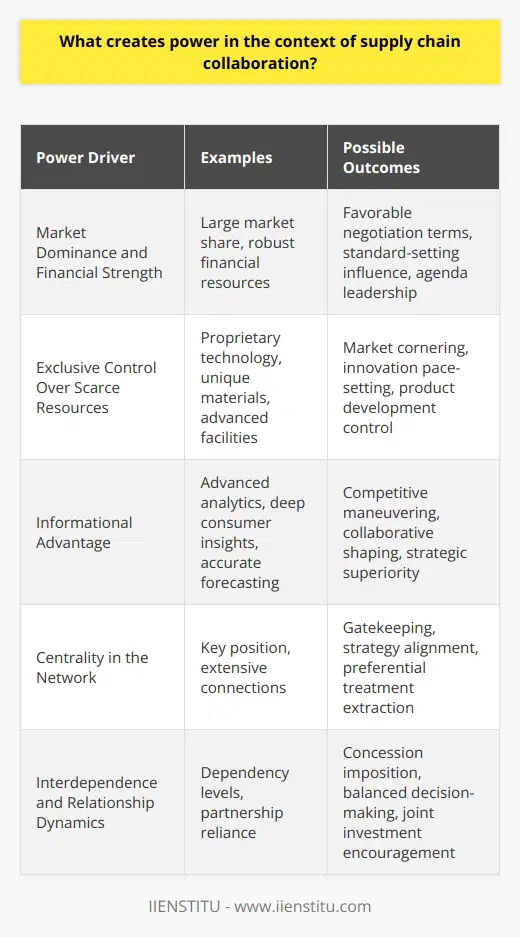
Why is system thinking important in supply chain management?
Significance of System Thinking in SCM
System thinking is crucial in supply chain management (SCM) as it enables comprehensive analysis and understanding of the intricate interdependencies among different processes, components, and stakeholders. By acknowledging that supply chains are complex, dynamic systems made up of interrelated activities, system thinking facilitates the identification of leverage points and opportunities for improvement.
Enhancing Decision-Making
In the context of SCM, system thinking empowers organizations to make informed decisions while considering both short-term and long-term consequences. Effective supply chain management, more than merely a set of isolated actions, is an integrated, holistic approach to coordinating resources, information, and activities across various functional areas. System thinking recognizes the ripple effects of various decisions, allowing managers to select the best options that align with the overall business strategy.
Optimizing Performance
System thinking also supports performance optimization through a continuous process of monitoring, evaluation, and adjustment. By providing a comprehensive view of the supply chain, the system-thinking approach helps identify bottlenecks, redundancies, and inefficiencies, leading to more effective allocation of resources and improved operational effectiveness. Additionally, the application of system thinking in the design and management of supply chains enables companies to shift from traditional, linear thinking to a more resilient and flexible approach, capable of adapting to changing market conditions.
Risk Mitigation and Resilience
One of the critical benefits of system thinking in SCM is its ability to enhance risk mitigation and resilience. By identifying weak links and potential sources of disruption, the system-thinking approach helps organizations to develop robust contingency plans and adopt proactive measures for minimizing vulnerabilities. This ultimately leads to a more reliable and resilient supply chain, better equipped to withstand disruptions and respond effectively to changing circumstances.
Fostering Collaboration
Lastly, system thinking fosters collaboration among stakeholders by emphasizing the importance of working together towards achieving shared goals. Ahealthy supply chain depends on effective communication, trust, and cooperation among its participants. By promoting a shared understanding of the entire system, system thinking creates a collaborative environment where all parties can contribute to optimizing supply chain performance, resulting in increased efficiency, competitiveness and, ultimately, success.
In conclusion, system thinking is an essential aspect of supply chain management, which helps organizations understand and navigate the complexity of their supply chains. Through enhanced decision-making, performance optimization, risk mitigation, and collaboration, the system-thinking approach contributes significantly to effective and resilient supply chain management.
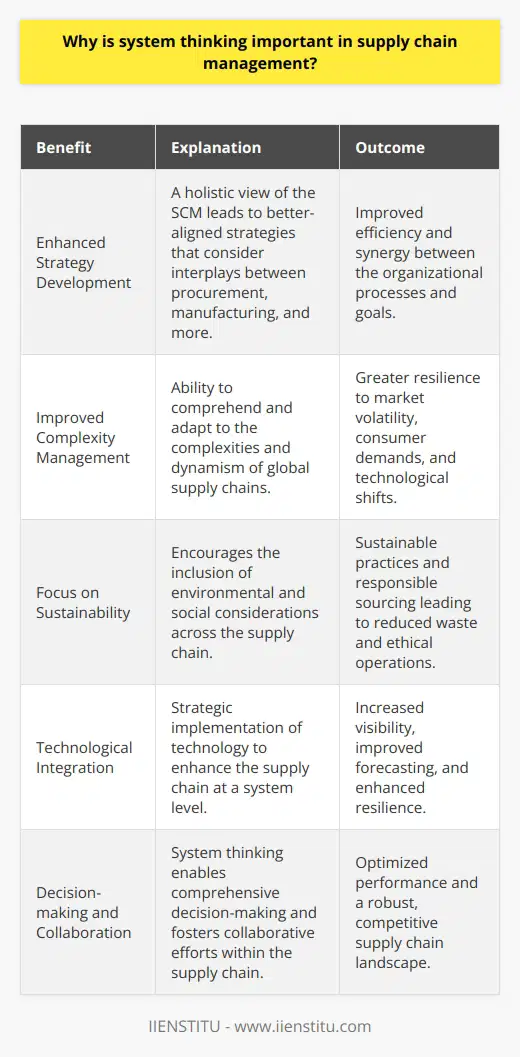
What is the power of system thinking in addressing complex problems and improving organizational efficiency?
System Thinking's Significance
The power of system thinking lies in its ability to provide a holistic perspective when addressing complex problems, thereby improving organizational efficiency. By considering the various parts of a system and their interconnections, organizations can identify patterns, anticipate consequences, and develop more effective strategies for solving problems and enhancing performance.
Effective Problem Solving
System thinking facilitates effective problem solving by enabling organizations to understand the root causes, rather than merely reacting to symptoms. This approach encourages a deeper comprehension of the underlying factors contributing to complex problems, fostering creative and innovative solutions that promote sustainable growth and development.
Enhanced Decision Making
The inclusive nature of system thinking also supports enhanced decision making. By considering the broader context and interdependencies within a system, decision-makers can evaluate the potential impact of their choices more thoroughly. This leads to better-informed decisions and a reduced likelihood of unintended consequences, ultimately promoting organizational efficiency.
Adaptability and Resilience
Another crucial advantage of system thinking is its ability to enhance adaptability and resilience. By identifying vulnerabilities and recognizing emerging trends, organizations can create more robust strategies to cope with uncertainties. This adaptability is essential for long-term success, particularly in today's rapidly changing global landscape.
Fostering Collaboration
System thinking promotes collaboration and effective communication between different organizational departments, facilitating a shared understanding of the system and its dynamics. By breaking down silos, organizations can synergize their efforts, resulting in more comprehensive and practical solutions that are better suited to tackle complex problems.
In conclusion, the power of system thinking is embodied in its capacity to improve organizations' efficiency by enabling them to tackle complex problems more effectively. By fostering a greater understanding of the relationships within a system, organizations can develop innovative solutions, enhance decision-making processes, and build resilience and adaptability to thrive in a rapidly changing world.
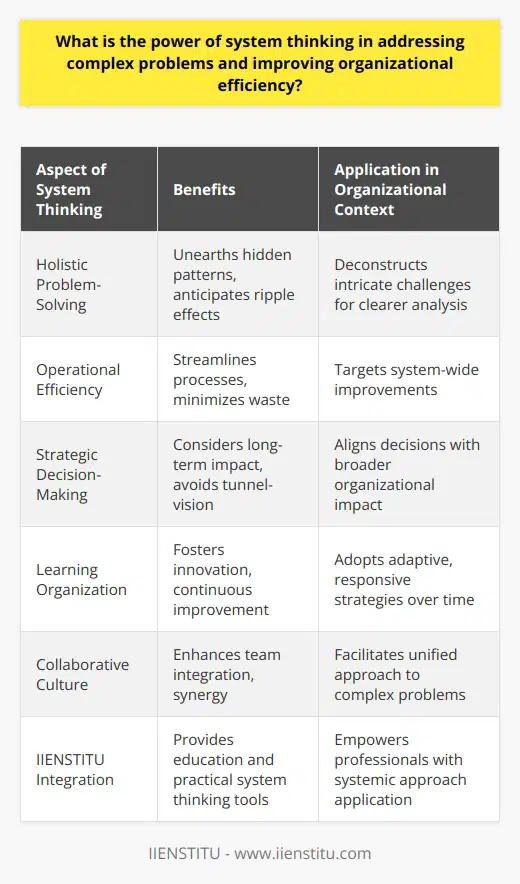
What is the systems thinking approach to design, and how does it facilitate the development of more effective and resilient supply chain networks?
Understanding Systems Thinking Approach
The systems thinking approach to design encompasses a holistic perspective that takes into account the interrelatedness and interdependence of all elements within a system. Rather than focusing on individual components in isolation, this approach seeks to comprehend the broader context, analyzing relationships, patterns, and feedback loops that shape a system's behavior.
Enhancing Supply Chain Effectiveness
By adopting a systems thinking perspective in the design of supply chain networks, it becomes possible to enhance their effectiveness. This can be achieved through the identification and optimization of critical connections and flows between different supply chain stages. Moreover, systems thinking enables the recognition of potential bottlenecks, inefficiencies, and redundancies, paving the way for streamlined processes and improved overall performance.
Promoting Resilience in Networks
Systems thinking also contributes to the development of more resilient supply chain networks by fostering adaptability and responsiveness to changing conditions. This is achieved by designing flexible practices and infrastructures, equipped to handle disruptions and variations in demand or supply. In addition, a systems thinking approach encourages robust risk management strategies and the implementation of redundancies to safeguard against potential shocks and vulnerabilities.
Fostering Collaboration and Synergy
A key aspect of systems thinking is recognizing the importance of collaboration and synergy for effective supply chain management. By emphasizing interconnectedness, this approach encourages organizations to engage in cooperative practices and establish strong relationships throughout the entire supply chain. This can help to facilitate better alignment between parties, enhance communication, and ultimately improve the efficiency and resilience of the entire network.
Nurturing Continuous Improvement
Lastly, the systems thinking approach plays a vital role in fostering a culture of continuous improvement within supply chain networks. By acknowledging that systems are dynamic and constantly evolving, this approach fosters adaptive learning and ongoing refinement of strategies. As a result, supply chain networks designed with a systems thinking perspective are better equipped to navigate the challenges and uncertainties of the global business landscape, ensuring their sustained competitiveness and success.
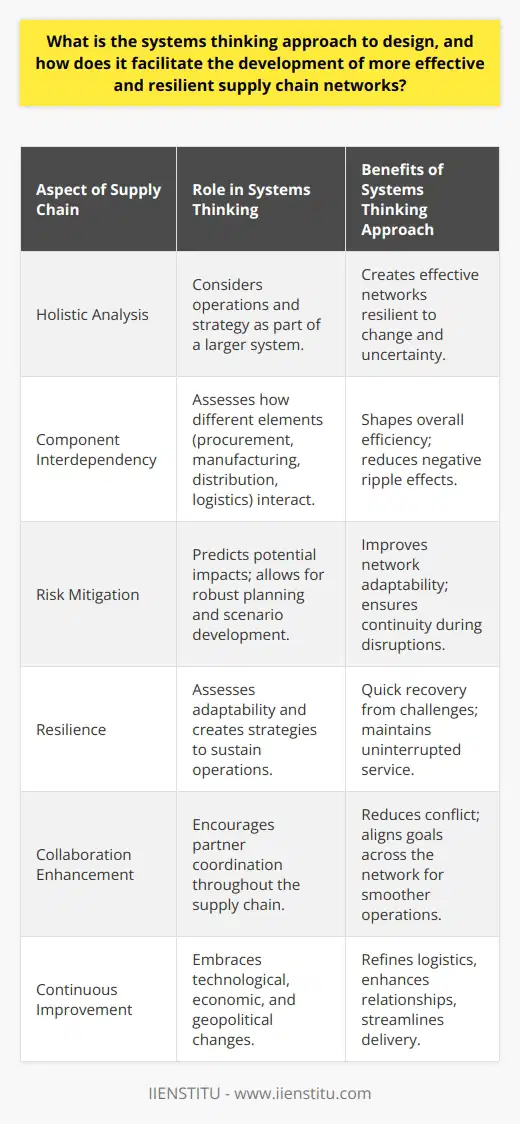
Why is system thinking important in supply chain?
Significance of System Thinking in Supply Chain
Enhancing Efficiency and Efficacy
System thinking is critically important in supply chain management as it facilitates a comprehensive understanding of complex and interconnected components. Adopting this method allows businesses to analyze the entire supply chain and make informed decisions that enhance efficiency and efficacy.
Proactive Management of Risks
By recognizing the interdependence of various elements within a supply chain, businesses can identify potential risks in a timely manner. With system thinking, proactive management of these risks becomes possible, contributing to the resilience and long-term success of the company.
Anticipating and Adapting to Change
The ever-changing market landscape requires companies to stay competitive and adapt to new trends and customer demands. Implementing system thinking allows supply chain managers to anticipate potential changes and make adjustments accordingly, ensuring seamless operations and enhanced customer satisfaction.
Sustainability and Environmental Responsibility
System thinking also promotes a broader perspective on environmental and social impacts of supply chain activities. This encourages companies to adopt sustainable practices, minimizing negative effects on the environment and complying with ethical standards.
Collaboration and Partnership Building
Given the complexity of modern supply chains, collaboration and partnership building has become increasingly essential. System thinking facilitates cross-functional communication and cooperation among various stakeholders, maximizing the potential to create synergies and leverage respective strengths.
In conclusion, system thinking enables businesses to have a holistic view of their supply chains, allowing them to identify opportunities for improvement, manage risks proactively, anticipate and adapt to changes, promote sustainability and foster collaboration. This comprehensive approach paves the way for successful supply chain management and overall business growth.
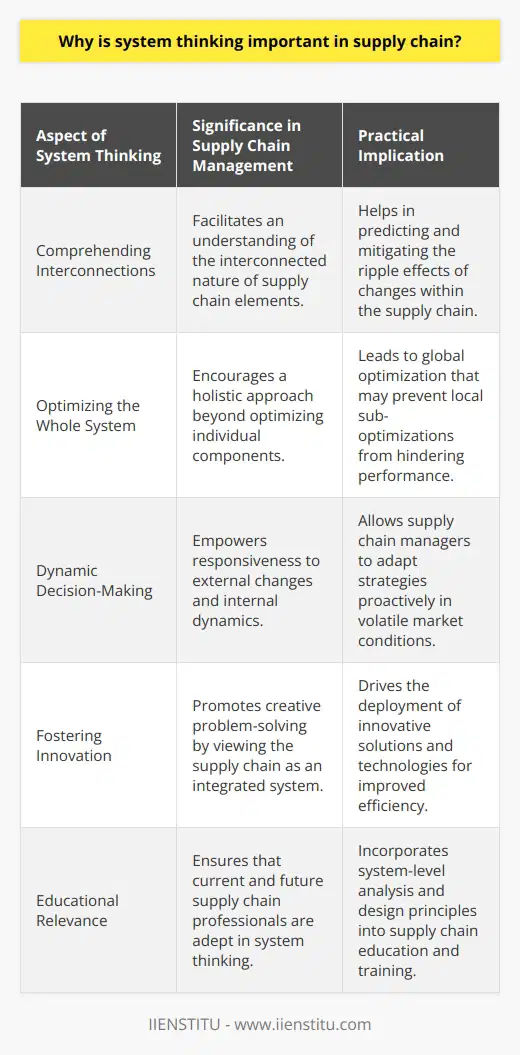
What is the power of systems thinking?
Defining Systems Thinking
Systems thinking is an analytical approach that incorporates the interactions and relationships between different elements in order to understand the behavior of a complex system. This intellectual framework allows for a holistic perspective on complex issues, taking into account how the diverse components of a system collectively contribute to its overall functioning and behavior.
Enhancing Problem Solving Abilities
The power of systems thinking stems from its ability to enhance individuals' problem-solving abilities by focusing on the bigger picture and identifying the root causes of problems. Instead of addressing individual issues in isolation, systems thinking enables practitioners to recognize patterns and connections among different elements, increasing the likelihood of developing effective, lasting solutions.
Promoting Collaboration and Communication
Furthermore, systems thinking promotes collaboration and communication across different disciplines and sectors. By identifying links and interdependencies among various system components, stakeholders from diverse backgrounds can better appreciate the need to work together to achieve common goals. This fosters openness, inclusion, and consensus-building, which are essential for driving change and addressing shared challenges.
Enabling Sustainability and Resilience
As a key feature of systems thinking, understanding the implications of actions and decisions on different system components promotes sustainability and resilience. By considering long-term consequences and potential system-wide effects, decision-makers are encouraged to select strategies that are adaptive, flexible, and least harmful to the environment and society. This ensures that solutions are designed to withstand uncertainties and achieve desired outcomes without compromising the well-being of future generations.
Fostering Adaptability and Innovation
Lastly, systems thinking fosters adaptability and innovation through continuous learning and experimentation. Recognizing that systems are dynamic and constantly evolving enables individuals and organizations to anticipate and respond effectively to emerging challenges and opportunities. By embracing uncertainty and fostering a culture of learning and innovation, systems thinking equips individuals and societies to adapt and thrive in a rapidly changing world.
In conclusion, the power of systems thinking lies in its ability to enhance problem-solving abilities, promote collaboration and communication, enable sustainability and resilience, and foster adaptability and innovation. By adopting this holistic approach to analyzing complex systems, individuals and organizations can better understand the dynamics of the world around them and develop effective strategies to tackle pressing challenges and seize new opportunities.
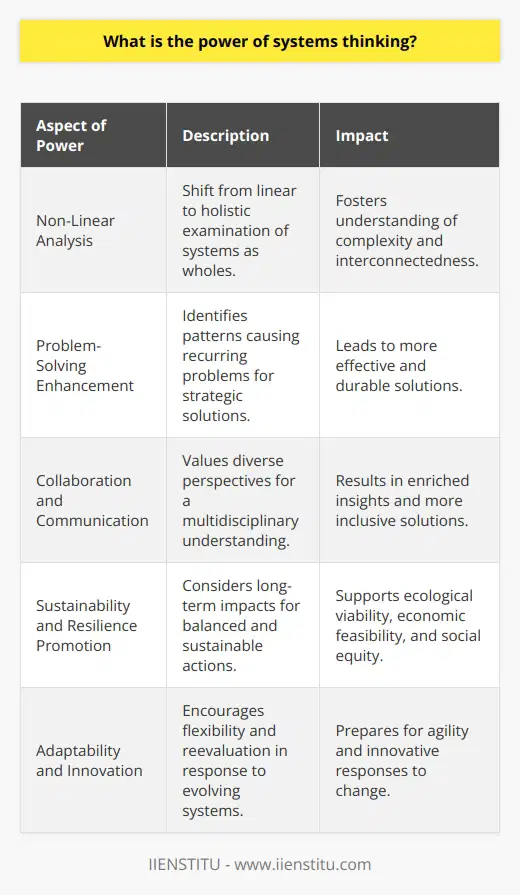
What is the systems thinking approach to design?
Systems Thinking in Design
A systems thinking approach to design adopts a holistic perspective, viewing a design challenge as part of a larger, interconnected context. Rather than simply focusing on individual components, designers employing this methodology examine the interdependencies and relationships between elements in the system. In turn, they aim to create well-rounded solutions that acknowledge complexity and tackle underlying issues.
Key Principles of Systems Thinking
Among the fundamental principles of systems thinking, the emphasis on recognizing connections and fostering feedback loops stands out. Practitioners strive to account for unintended consequences and potential side effects through comprehensive analysis. This approach also highlights the importance of historical context, learning from past experiences to inform design decisions.
Holistic Analysis and Synergy
A pivotal aspect of this approach is analyzing the design challenge from multiple perspectives, exploring potential scenarios and embracing diverse stakeholder viewpoints. Systems thinking acknowledges that factors influencing problems are often deeply interconnected, leading designers to prioritize holistic problem-solving over isolated solutions. This dynamic and synergistic mindset does not sacrifice the integrity of individual components but seeks to optimize their contributions to the larger system.
Iterative and Adaptive Process
Systems thinking in design embraces an iterative and adaptive process, continually refining solutions based on feedback and evolving conditions. Designers remain flexible, adjusting their approach as new insights emerge. This fosters a continuous learning environment, encouraging the incorporation of recent advances or previously unconsidered factors to create more resilient and robust solutions.
The Role of Collaboration
Collaboration plays a crucial role in the systems thinking approach. Inviting diverse perspectives enriches the design process, ensuring more comprehensive and nuanced outcomes. Working across disciplinary boundaries allows for a broader understanding of complex systems, promoting innovative and inclusive solutions that cater to numerous stakeholders.
Conclusion: Towards Sustainable Solutions
Ultimately, the systems thinking approach offers a more sustainable pathway to design. By considering the entire system and accounting for potential externalities, designers can create solutions that minimize negative impacts and maximize synergistic benefits. As our world grows increasingly complex and interconnected, this holistic perspective gains significance, guiding the development of design practices adaptable to rapidly changing environments.
